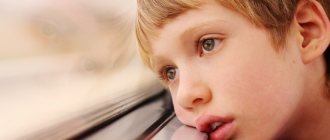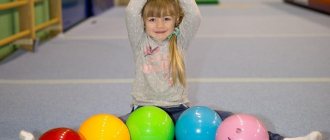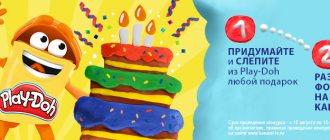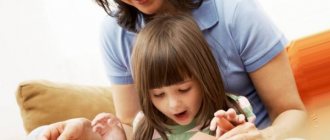Autism - what kind of disease is it? Causes of autism, symptoms and early signs
Autism in children is a special personality disorder, which, although characterized by a violation of social behavior and adaptation to environmental conditions, is not a disease.
The syndrome develops in the first years of a child’s life, when there is an absence or inadequate reaction to auditory or visual stimuli, strange fears, and repetitive behavior. If similar symptoms are observed in a teenager, this diagnosis is doubtful.
The level of intellectual development in this disease can be very different: from profound mental retardation to giftedness in certain areas of knowledge and art; In some cases, children with autism have no speech, and there are deviations in the development of motor skills, attention, perception, emotional and other areas of the psyche. More than 80% of children with autism are disabled.
Causes of autism
Most often, children with RDA are physically absolutely healthy; they do not show any visible external defects. In mothers, pregnancy proceeds without any special features. In sick babies, the structure of the brain is practically no different from the norm. Many even notice the special attractiveness of the facial part of an autistic child.
However, in some cases, other signs of the disease still appear:
- maternal infection with rubella during pregnancy;
- chromosomal abnormalities;
- tuberous sclerosis;
- cerebral palsy;
- violation of fat metabolism - obese women have a high risk of giving birth to a child with congenital autism.
All of the above conditions have a negative impact on the child’s brain and can lead to the development of autism. According to research, genetic predisposition plays a role: if there is an autistic person in the family, the risk of developing the disease increases. However, reliable reasons have not yet been identified.
Symptoms of autism in a child
In some children, symptoms of autism can be detected as early as infancy. Autism most often appears by age three. Signs of autism may vary depending on the child's developmental level and age (see photo).
Behavioral characteristics used to describe autism syndrome:
The development of non-speech and speech communication is impaired. Characteristic:
- Speech is normal, but the child cannot talk with others;
- The speech is abnormal in content and form, that is, the child repeats phrases heard somewhere that do not apply to the given situation;
- Lack of facial expressions and gestures. Speech may also be absent;
- The child never smiles at the interlocutor, does not look him in the eyes;
- Speech is phonetically abnormal (problems with intonation, rhythm, monotony of speech).
The development of imagination is impaired, which leads to a limited range of interests. Characteristic:
- Preference is given to solitude, playing with oneself;
- Lack of imagination and interest in imaginary events;
- gravitates toward a certain object and experiences an obsessive desire to constantly hold it in his hands;
- Unnatural, nervous, aloof behavior;
- An autistic child exhibits tantrums when the environment changes;
- Experiences a requirement to repeat the same actions exactly;
- Concentrates his attention on one thing.
The development of social skills is impaired. Characteristic:
- Ignoring the feelings and existence of other people (even parents);
- They don’t share their problems with loved ones because they don’t see the need for it;
- Children do not want to communicate and make friends with their peers;
- They never imitate the facial expressions or gestures of other people or repeat these actions unconsciously, without connecting them in any way with the situation.
People with autism are characterized by uneven development, which gives them the opportunity to be talented in some narrow area (music, mathematics). Autism is characterized by impaired development of social, thinking, and speech skills.
Autism in a child over 11 years old
Simple communication skills have been mastered, but the child prefers to spend time in a deserted room. Other signs are also noted:
- interest is directed only to one area, a toy, a cartoon, a program;
- attention deficit;
- aimless complex movements;
- compliance with one’s own, often ridiculous from the outside, rules;
- strange fears also occur;
- hyperactivity;
- the need for a uniform arrangement of furniture and things in the house - if it is moved, the child may have a hysteria or panic attack;
- the child must follow a certain sequence when dressing, waking up, and going to bed;
- self-directed aggression.
Teaching children with autism is difficult, but this does not mean that all autistic people have a low IQ - it is difficult for them to quickly change their activity and focus their attention equally on several objects. Parenting requires enormous effort on the part of parents: after all, if a child has learned to go to the potty or change clothes at home, this does not mean that he will be able to do this at a party or in kindergarten.
Symptoms of the disease between the ages of 2 and 11 years
Children with autism at this age still experience symptoms that were relevant for the previous period. The child does not respond to his own name, does not look him in the eye, likes to be alone, and has no interest in other children. In addition, other characteristic symptoms of the disease are noted:
- Perhaps, again, repetition of the same type of actions (peculiar rituals), when changing his usual environment, he becomes very anxious.
- The child knows only a few words and may not speak at all.
- The child may constantly repeat the same word; he does not maintain a conversation.
- For the most part, children with autism struggle to acquire skills that are new to them; at school age they lack the ability to read or write.
Some children develop an interest in a certain type of activity, for example, mathematics, music, drawing, etc.
Autism
Mandatory signs of childhood autism (typical autistic disorder, Kanner syndrome) are a lack of social interactions, problems in building productive mutual contact with others, stereotypical behavior and interests. All of these signs appear before the age of 2-3 years, while individual symptoms indicating possible autism are sometimes detected in infancy.
Impaired social interactions are the most striking feature that distinguishes autism from other developmental disorders. Children with autism cannot fully interact with other people. They do not feel the state of others, do not recognize non-verbal signals, and do not understand the subtext of social contacts. This symptom can already be detected in infants. Such children react poorly to adults, do not make eye contact, and are more willing to fix their gaze on inanimate objects rather than on the people around them. They do not smile, react poorly to their own name, and do not reach out towards an adult when trying to pick them up.
Growing up, patients do not imitate the behavior of others, do not respond to the emotions of other people, do not participate in games designed for interaction, and do not show interest in new people. They become strongly attached to loved ones, but do not show their affection like ordinary kids - they do not rejoice, do not run towards them, do not try to show adults toys or somehow share events from their lives. The isolation of autistic people is not due to their desire for loneliness, but to their difficulties due to the inability to build normal relationships with others.
Patients begin to speak later, babble less and less frequently, and later begin to pronounce individual words and use phrasal speech. They often confuse pronouns and call themselves “you,” “he,” or “she.” Subsequently, high-functioning autistic people “gain” a sufficient vocabulary and are not inferior to healthy children when taking tests of word knowledge and spelling, but they experience difficulty when trying to use images, draw conclusions about what is written or read, etc. In children with low-functioning forms of autism speech is significantly impoverished.
Children with autism typically use unusual gestures and have difficulty using gestures when interacting with others. In infancy, they rarely point to objects or, when trying to point to an object, they look not at it, but at their hand. As they get older, they are less likely to say words while gesturing (healthy children tend to gesture and speak at the same time, for example, extending their hand and saying “give”). Subsequently, it is difficult for them to play complex games, organically combine gestures and speech, and move from simpler forms of communication to more complex ones.
Another telltale sign of autism is restricted or repetitive behavior. Stereotypes are observed - repeated body swaying, head shaking, etc. It is very important for patients with autism that everything always happens in the same way: objects are placed in the right order, actions are performed in a certain sequence. A child suffering from autism may begin to scream and protest if his mother usually puts on his right sock first, and then the left, but today she did the opposite, if the salt shaker is not in the center of the table, but shifted to the right, if instead of the usual cup he was given a similar one, but with a different pattern. At the same time, unlike healthy children, he does not show a desire to actively correct the state of affairs that does not suit him (reach for his right sock, rearrange the salt shaker, ask for another cup), but in ways accessible to him signals that what is happening is wrong.
An autistic person's attention is focused on details, on repeating scenarios. Children with autism often choose non-play objects rather than toys for play; their games lack a plot basis. They do not build castles, do not roll cars around the apartment, but arrange objects in a certain sequence, aimlessly, from the point of view of an outside observer, move them from place to place and back. A child with autism may be extremely attached to a particular toy or non-play object, may watch the same television program at the same time every day without showing interest in other programs, and be extremely intensely worried if this program is not on any program. That's why I couldn't watch it.
Along with other forms of behavior, repetitive behavior includes auto-aggression (hitting, biting and other self-inflicted injuries). According to statistics, approximately a third of autistic people show self-aggression throughout their lives and the same number show aggression towards others. Aggression, as a rule, is caused by attacks of anger due to a violation of the usual life rituals and stereotypes or due to the inability to convey one’s desires to others.
The opinion about the obligatory genius of autistic people and the presence of some unusual abilities is not confirmed by practice. Individual unusual abilities (for example, the ability to remember details) or talent in one narrow area with deficits in other areas (savantism) are observed in only 0.5-10% of patients. Children with high-functioning autism may have average or slightly above average intelligence. With low-functioning autism, a decrease in intelligence is often detected, up to and including mental retardation. In all types of autism, generalized learning disabilities are common.
Among other optional but quite common symptoms of autism, it is worth noting seizures (detected in 5-25% of children, most often appear for the first time at puberty), hyperactivity syndrome and lack of attention, various paradoxical reactions to external stimuli: touches, sounds, changes in lighting . There is often a need for sensory self-stimulation (repetitive movements). More than half of autistic people exhibit deviations in eating behavior (refusal to eat or refusal of certain foods, preference for certain foods, etc.) and sleep disorders (difficulty falling asleep, night and early awakenings).
Signs of early childhood autism under 2 years of age
In most cases, manifestations of the disease are observed in children during the first year of their life. There may be characteristic differences in the behavior of a sick child from the behavior of peers. The following symptoms are also noted:
- The child rarely smiles;
- There is no attachment to the mother. So, the child does not cry like other children when she goes somewhere, he does not smile at her and does not reach out for her arms;
- A child with autism does not look at the parents’ face, into their eyes;
- The child may have an inadequate response to stimuli that are insignificant for others (light, muffled sounds, etc.), in addition, he may experience fear because of them.
- The child is noted to be aggressive towards other children, he does not strive to communicate with them and to play together;
- A sick child gives preference to only one toy (or a separate part of it) in play; there is no interest in other toys;
- There is a delay in speech development. So, by 12 months the child does not babble, does not use the simplest words by the age of 16 months, and by the age of 24 months does not reproduce simple phrases.
Meanwhile, it is important to note that such symptoms are not at all exclusive indicators of the relevance of autism, although they require some concern. Therefore, the child’s avoidance of society, his silence, self-absorption - all these manifestations must be discussed with the pediatrician.
Autism in children: signs, symptoms
Children have difficulty interacting in a team. They have difficulty making contact and do not know how to maintain it for a long time. Children are cold in communication, have a low level of empathy, do not understand the feelings and desires of other people, and do not strive for friendship.
The speech of a child with autism is specific. The baby uses it to describe his needs, has difficulty understanding the true meaning of what is said, and interprets speech literally. Children rarely use gestures and do not know how to interpret them in conversations with others.
The thinking of an autistic person is characterized by viscosity and poverty, which is expressed in ritualistic behavior. It is important for children to follow the sequence of actions. The child reacts excitedly to the slightest changes in the daily routine, begins to scream, and may panic.
Children with autism are characterized by high anxiety, vulnerability, and inability to adapt skills to a new situation. They have difficulty with self-care, organization and planning activities.
Features of sensory perception
Children have difficulty perceiving sensations. Some are hypersensitive. They may be irritated by loud music and smells. They try to block the irritating factor. Other children have difficulties with sensory perception. They require a strong influence of the factor.
Features of sensory perception are expressed in the behavior and movement of babies:
- walking on toes;
- covering your ears with your palms;
- whirling, rocking;
- avoiding physical contact;
- negative reaction to contact with a certain texture of materials;
- unwillingness to remain in the dark;
- the desire to lick or chew unfamiliar objects;
- insufficient or excessive reaction to irritation (heat, cold, pain);
- desire to wear tight, tight clothes.
The spectrum of manifestations of autism is so diverse that it is difficult to classify. The severe course of the disease is expressed in the desire to avoid contacts and isolate. The child has difficulty with visual and physical contact and is hypersensitive. Many children have a very close emotional connection with their mother. With a mild degree of autism, the child exhibits specific traits: emotional coldness, callousness, lack of empathy, difficulty interacting with peers. In a broad sense, autism can be perceived as a disconnect from reality, a violation of connection with reality.
The paradoxical behavior of a child is expressed in the simultaneous search for the same type of impressions, hyper-prejudice and lack of interest in the world.
Adaptation disorder
Polarity and paradoxical behavior is expressed in a combination of fearlessness and hyper-caution. In one situation, the baby is afraid to climb the steps, in another, he calmly hangs his legs out of the window at a great height.
Children exhibit oddities in eating behavior: simultaneous disgust and selectivity, a desire to try inedible foods, a desire to overeat or starve.
He does not know how to use appliances, but at the same time he is extremely neat and pedantic in everyday life. Painfully perceives the rearrangement of furniture, the absence of things in their usual places.
Research has shown that only 5% of adults with autism adapt well to social life. Three quarters of the subjects need care and daily assistance. Even well-adapted people experience difficulties: they periodically experience anxiety and a sense of danger in relation to situations and people. Fears “pop up” when an autistic person is faced with a traumatic situation. Many people with autism exhibit strange interests and fantasies that can surprise and frighten others.
IQ level in autism
Most children with autism have mild or moderate mental retardation. It is associated with brain defects and learning difficulties. If the disease is combined with microcephaly, epilepsy and chromosomal abnormalities, then the level of intelligence corresponds to severe mental retardation. With mild forms of the disease and dynamic development of speech, intelligence can be normal or even above average.
The main feature of autism is selective intelligence. That is, children can be strong in mathematics, music, and drawing, but at the same time be far behind their peers in other respects. The phenomenon when an autistic person is extremely gifted in some area is called savantism. Savants can play a melody after hearing it just once. Or paint a picture seen once, accurate to halftones. Or keep columns of numbers in your head, performing complex computational operations without additional means.
Severity
There are several degrees of severity, which make it even more clear what autism is:
| 1st degree | Children can communicate, but in unusual surroundings they are easily lost. Movements are awkward and slow; the child does not gesture, his speech is amicable. Sometimes such children are diagnosed with mental retardation. |
| 2nd degree | Children do not appear withdrawn or aloof. They talk a lot, but do not address anyone. They especially love to talk about their area of interest, which they have studied thoroughly. |
| 3rd degree | In a familiar environment, the child behaves normally, but when visiting new places he has an attack of panic or self-injury. Such a patient confuses pronouns and answers with useless cliches. |
| 4th degree | Children do not respond to treatment, do not make eye contact, and practically do not speak. If they are comfortable, they sit for hours, looking ahead, discomfort manifests itself in screaming and crying. |
Diagnosis of autism
External clinical signs of autism in a child of the first year of life are practically absent, and only experienced parents with more than 1 child in the family manage to notice any developmental abnormalities with which they consult a doctor.
If there are already cases of autism in the family or lineage, then it is extremely important to carefully monitor the child and promptly seek medical help if necessary. The sooner a child is diagnosed, the easier it will be for him to adapt to the world and society around him.
The main methods for diagnosing autism in children are:
- examination of the child by an otolaryngologist and a hearing test - this is necessary to exclude delayed speech development due to hearing loss;
- EEG – carried out to detect epilepsy, since sometimes autism can manifest itself as epileptic seizures;
- Ultrasound of the brain - allows you to identify or exclude damage and abnormalities in the structure of the brain that can provoke symptoms of the disease;
- conducting tests with special questionnaires.
Parents themselves must correctly assess changes in the behavior of a child who may have autism.
Vitamins during pregnancy and autism in the baby
A connection has been established between taking vitamin and mineral supplements and the risk of having a child with autism. Two groups of children were taken for the study: with typical development and with autism. An analysis of the collected data showed that those women who did not pay due attention to nutrition and vitamins were more likely to have children with autism.
With a lack of vitamins, deviations in the development of the baby occur (with a high degree of probability) from 1 to 8 weeks of pregnancy. The influence of unfavorable factors at a later date is not critical.
Expectant mothers are recommended 3 months before conception and in the first weeks of pregnancy to especially carefully monitor their diet, lifestyle, and be sure to take prenatal vitamins. A pregnant woman needs folic acid, B12, B6 and iron in larger quantities than is found in conventional multivitamin complexes.
Medical expert-editor Aleksey Alexandrovich Portnov advises choosing vitamins carefully, only with a doctor’s recommendation, after examining the general condition and analyzing the blood counts of the expectant mother. It has been noted that vitamins in effervescent form are absorbed by the body better than tablet preparations.
Treatment of autism
The answer to the main question: is autism treatable? -No. There is no cure for this disease. There is no pill that, after drinking, will help an autistic child come out of his “shell” and become socialized. The only way to adapt an autistic person to life in society is through persistent daily practice and the creation of a favorable environment. This is a lot of work by parents and teachers, which almost always bears fruit.
Principles of raising an autistic child:
- Create a favorable environment for the child’s life, development and learning. A frightening environment and an unstable daily routine slow down an autistic person’s skills and force them to “withdraw” even deeper.
- Understand that autism is a way of being. A child with this condition sees, hears, thinks and feels differently from most people.
- Involve a psychologist, psychiatrist, speech therapist and other specialists in working with the child if necessary.
At the present stage, help for sick children can only be provided by a correctional program drawn up by a competent specialist - a sequence of actions that are carried out not to cure autism (it cannot be treated), but with the goal of maximizing the child’s adaptation to environmental conditions.
To implement this program, the help of parents is very important, because for the baby the whole world is incomprehensible and hostile.
Correction is carried out in special rehabilitation centers (for example, Our Sunny World or Childhood). The correction program depends on the form and severity of the disease. It includes:
- drug treatment;
- gluten-free diet;
- hippotherapy;
- behavioral therapy;
- music therapy;
- play therapy;
- exercise therapy;
- dolphin therapy;
- massage.
Classes of different types of therapy can be conducted in different centers. Thus, hippotherapy is usually carried out in a specially equipped arena, music treatment is carried out in special rooms. Physical therapy and massage are usually carried out in the same clinic.
Autism in questions and answers: part 1
Date of publication: 08/17/2020 Articles
Is autism a disease?
No, autism is a developmental disorder that accompanies a person throughout his life. The main difference between a disease and a disorder is that a disease has a beginning, a course and an end. But today the dominant view in science is that autism appears due to genetic reasons, which means that the child has it from birth. You cannot get autism or get it from someone else. Therefore, it is correct to call autism not a disease, but a developmental disorder.
Natalya Ustinova, psychiatrist, MD, member of the scientific expert council of the “Vykhod” Foundation: It seems to me that one should not excessively contrast illness with developmental disorders, although some differences in these concepts do exist. However, the criteria that are proposed as differential diagnostics between a developmental disorder and a disease are not universal, since there are hereditary diseases, such as phenylketonuria and tuberous sclerosis, that are not called developmental disorders. Schizophrenia also cannot be contracted from someone. Autism spectrum disorders (ASD) are now considered to be developmental disorders. But it is not a fact that in the future they will not, in whole or in part, become a disease. It may be preferable to call ASD a developmental disorder in social discourse, although in medical terms it may appear to be a complex disorder. In any case, until the underlying causes of the condition are established, emphasizing the already somewhat artificial dilemma: disorder or disease looks like a game of terms.
How is Asperger's syndrome different from other autism spectrum disorders?
From a diagnostic standpoint, nothing. The differences between Asperger's syndrome are the absence of communicative language and speech disorders in people with this diagnosis, as well as the absence of intellectual impairments. In the International Classification of Diseases, 11th revision (to come into force in 2022), there will be no such diagnosis as “Asperger syndrome”. It will fall under the category of “autism spectrum disorder.” Due to changes in diagnostic classification, the term “Asperger syndrome” will soon be considered obsolete. Already today, in connection with the emergence of information about Hans Asperger’s collaboration with the fascist regime, there are discussions that the use of the term “Asperger syndrome” is not at all ethical.
Natalya Rakhlina, linguist, assistant professor of linguistics at Wayne State University, specialist in language development in children and developmental language and speech disorders: His work as the chief child psychiatrist in Vienna directly served the ideology of National Socialism and the system of extermination of children with disabilities. He was involved in the implementation of the Nazi law for the prevention of hereditary diseases of descendants, which required the destruction of genetically “unfit” children.
Can you self-diagnose Asperger's syndrome?
No, diagnosing developmental disorders is the task of a qualified specialist. But you can notice your symptoms and consult a doctor, telling him about your concerns. Elizaveta Meshkova, psychiatrist, member of the Association of Psychiatrists and Psychologists for Evidence-Based Practices, expert at the Exit Foundation: In my practice and the practice of my colleagues, there are quite a lot of stories about self-diagnosis of Asperger’s syndrome. As a rule, this is done by adults who accidentally found a description of the syndrome, recognized themselves in this description, underwent testing and psychological examination, and finally received an answer to the question “why is it so difficult for me to communicate.” Self-diagnosis in our country is often not a bad way to suspect a diagnosis. But the question of diagnosis and differential diagnosis should still be raised before a psychiatrist or psychologist.
If you suspect your child has autism spectrum disorder, contact a psychiatrist for advice.
The material was prepared by Stavropol Psychiatric Hospital No. 1 based on information from the “Vykhod” Foundation
Watch and read us on social networks
The illustration for this publication was taken from the public image library https://www.freepik.com/ and from open sources. You can read in detail about using illustrations from the Freepik library here
What to do?
Yes, autism is a child development disorder that lasts throughout life. But thanks to timely diagnosis and early correctional assistance, much can be achieved: adapt the child to life in society; teach him to cope with his own fears; control emotions.
- The most important thing is not to disguise the diagnosis as supposedly “more harmonious” and “socially acceptable.” Do not run away from the problem and do not focus all your attention on the negative aspects of the diagnosis, such as disability, misunderstanding of others, conflicts in the family, etc. An exaggerated idea of a child as a genius is just as harmful as a depressed state from his failure.
- It is necessary without hesitation to abandon tormenting illusions and plans for life built in advance. Accept the child for who he really is. Act based on the child’s interests, creating an atmosphere of love and goodwill around him, organizing his world until he learns to do it on his own.
Remember that a child with autism cannot survive without your support.
Features of the disease in adults
Aspreger's autism syndrome is quite common in adults. Symptoms that appeared in childhood may persist or transform, changing their severity. The development of autism in adulthood usually leads to the appearance of an atypical form with a mild degree of severity or the manifestation of not all symptoms. Asperger's syndrome has been identified in many talented programmers, writers, and scientists. Rett syndrome is the result of changes formed in childhood, the progression of which leads to deformations of the musculoskeletal system and mental retardation.
Often autism in adults, the symptoms of which depend on the degree of manifestation of the pathology, remains undiagnosed. Touchiness and dependence on other people's opinions of patients are attributed to character traits, which can result in the transition of the disease to a severe form. Timely diagnosis and quality treatment allow the patient to successfully cope with many problems.
Teaching an autistic child
An autistic child, as a rule, cannot study in a regular school. More often, homeschooling is done by parents or a visiting specialist. Special schools have been opened in large cities. Training there is carried out using special methods.
The most common training programs:
- “Time on the floor”: the technique suggests treatment and teaching communication skills to be carried out in a playful way (a parent or teacher plays with the child on the floor for several hours).
- “Applied Behavior Analysis”: step-by-step training under the guidance of a psychologist from simple skills to the formation of spoken language.
- The “More Than Words” program method teaches parents to understand the nonverbal way of communicating with a child using gestures, facial expressions, his gaze, etc. The psychologist (or parents) help the child develop new methods for communicating with other people that are more understandable to them.
- Card exchange teaching method: used for severe autism and when the child has no speech. During the learning process, the child is helped to remember the meaning of various cards and use them for communication. This allows the child to take initiative and facilitates communication.
- “Social stories” are original fairy tales written by teachers or parents. They should describe situations that cause the child’s fears and anxiety, and the thoughts and emotions of the characters in the stories suggest the child’s desired behavior in such a situation.
- The TEASSN program: the methodology recommends an individual approach to each child, taking into account his characteristics and learning goals. This technique can be combined with other teaching technologies.
A strict daily routine, constant and not always successful activities with a child suffering from autism leave an imprint on the life of the entire family. Such conditions require extraordinary patience and tolerance from family members. But only love and patience will help you achieve even the slightest progress.
Prognosis for autism
The number of British studies talking about qualitative changes and devoted to long-term prognosis is small. Some autistic people experience minor improvements in their communication skills as adults, but for many more these skills worsen.
The prognosis for the development of autism is as follows: 10% of adult patients have several friends and require some support; 19% have a relative degree of independence, but remain at home and require daily supervision, as well as significant support; 46% require specialist care for autism spectrum disorders; and 12% of patients require highly organized hospital care.
Swedish data from 2005 in a group of 78 autistic adults showed even worse results. Of the total, only 4% lived an independent life. Since the 1990s, as well as the early 2000s, the increase in reports of new cases of autism has increased significantly. Since 2011-2012, autism spectrum disorder has been observed in every 50th schoolchild in the United States, as well as in every 38th schoolchild in South Korea.
Gluten as a provocateur of developmental disabilities
Recently there has been talk that one of the factors causing autism in children and adults may be gluten food intolerance. As is known, the clinical manifestation of such a deviation is celiac disease. Indeed, a positive effect was observed when following a gluten-free diet for autism spectrum disorders.
Subsequently, scientists refuted the existing connection between celiac disease and the occurrence of autism in children, but confirmed that an increased risk of developing this disease exists in those people who have normal intestinal mucosa, but at the same time have a positive test for antibodies to gluten components.
It turns out that pathological conditions in autism do not develop with clinical manifestations of gluten intolerance, that is, celiac disease, but directly under the influence of gluten. The theory that immunological intolerance to gluten components may underlie the mechanism of development of autism spectrum disorders has been confirmed.
That is why, when treating autism, a nutritionist must prescribe a gluten-free diet, which significantly improves cognitive function in affected children.









